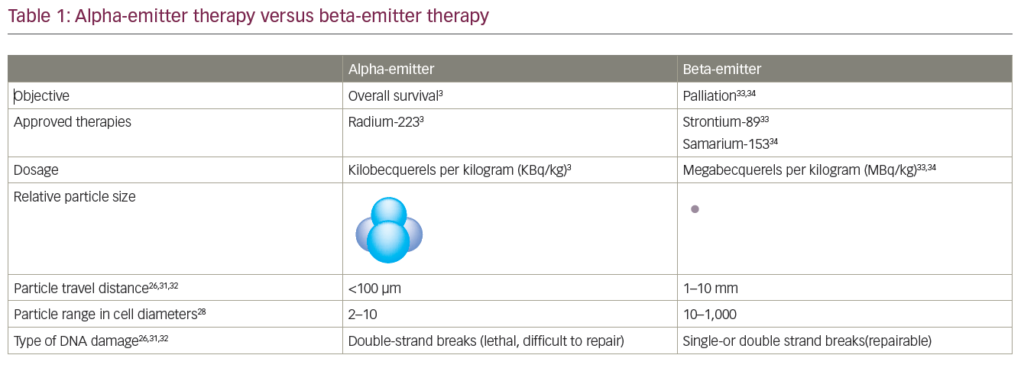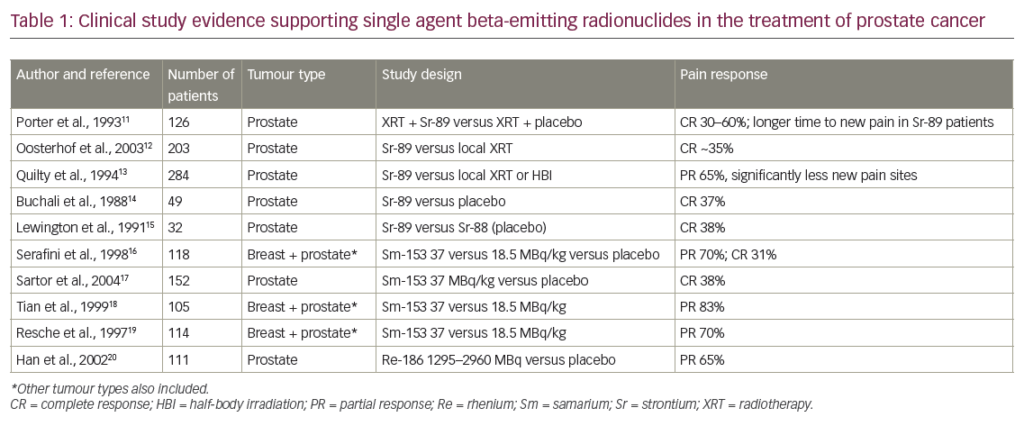Prostate cancer is the second most common cause of cancer death in men in the USA and the third most common cause of death in developed countries.1 For patients with metastatic prostate cancer, androgen deprivation therapy via medical or surgical castration is the standard treatment for improving symptoms and to prolong progression-free survival.2 After a mean duration of three to four years, all patients invariably develop progressive disease despite the presence of castrate testosterone serum levels. On the basis of an improvement in survival compared to mitoxantrone (Onkotrone; Baxter) plus prednisone in patients with metastatic castration-resistant prostate cancer (CRPC), docetaxel (Taxotere; Sanofi) in combination with prednisone is the standard, guideline-recommended first-line chemotherapy in this setting.3,4 Docetaxel has been proven to prolong survival time by three months when compared with mitoxantrone.
Despite its high therapeutic efficacy, however, all patients will ultimately experience disease relapse within six to eight months of the last cycle of treatment with docetaxel. Until recently, no second-line treatment had been approved by the US Food and Drug Administration (FDA) for the management of recurrent castration- and docetaxel-resistant prostate cancer. A variety of therapeutic approaches has been used in daily clinical routine, including docetaxel rechallenge, low dose metronomic docetaxel, siltiximab, paclitaxel and carboplatin, among others.5–7 However, at best, only an improvement of progression-free survival time was achieved; none of the various approaches resulted in a prolongation of survival. In 2011, two drugs – the CYP17 inhibitor abiraterone acetate (Zytiga; Janssen) and the tubuline-binding taxane cabazitaxel (Jevtana; Sanofi) – were approved by the FDA on the basis of their significant survival benefit when compared to placebo and to mitoxantrone.8,9
Characteristics of Cabazitaxel
Cabazitaxel is a tubulin-binding taxane drug as potent as docetaxel in cell lines.10–13 In addition, the drug has antitumour activity in models resistant to paclitaxel and docetaxel.10–13 Cabazitaxel has been shown to have a lower affinity for the drug resistance mediator P-glycoprotein compared to the other taxanes (docetaxel and paclitaxel), so that it is still active in docetaxel-resistance cancer cells.14 Preclinical studies in rats and mice have also demonstrated that cabazitaxel is able to cross the blood–brain-barrier, so it may also have clinical benefit in patients with intracerebral metastases or leptomeningiosis carcinomatosa.15
The TROPIC Trial
Patients and Methods
Following positive results in Phase I clinical studies in CRPC, the therapeutic efficacy of cabazitaxel was tested in a prospective, randomised, multicentre, multinational, Phase III clinical trial (EFC6193; TROPIC), which included 755 patients with metastatic CRPC who had progressed after docetaxel-based chemotherapy.5 Eighty-seven percent of patients had received one docetaxel-based cytotoxic regime, and 12 % and 2 % of patients had received two and three docetaxel-based cytotoxic regimes, respectively. About 25 % of patients had received three to six cycles of docetaxel and prednisone, while 30 % and ~20 % had received six to nine cycles and ≥10 cycles of treatment, respectively.
Patients were randomised to receive either cabazitaxel at 25 mg/m2 intravenously over one hour, or mitoxantrone at 12 mg/m2 over 15–30 minutes, once every 21 days. All patients received prednisone 5 mg twice daily throughout the treatment period.
The primary study goal was improvement of overall survival (OS). Secondary study endpoints were progression-free survival (PFS), prostate surface antigen (PSA) response rate, objective remission rate and safety. It was intended that patients should receive at least six cycles of treatment, ideally up to 10 cycles should be applied.
Oncological Results
After a mean follow-up of 12.8 months a significant survival benefit of 2.4 months was documented for the cabazitaxel group: mean survival increased from 12.7 months to 15.1 months (p<0.0001). However, this was only achieved for patients who received a cumulative docetaxel dose of at least 225 mg/m2, which might have been because the PSA increase in patients with a cumulative dose <225 mg/m2 was due to a PSA flare-up phenomenon, and not due to progression of taxane-resistant prostate cancer. In fact, patients with a cumulative dose <225 mg/m2 were only excluded from the ongoing trial by a subsequent protocol amendment. A total of 59 patients with a cumulative docetaxel dose <225 mg/m2 had been recruited prior to the amendment.
Among the secondary endpoints, significant increases in PFS (2.8 versus 1.4 months, p=0.0005), PSA response rate (39.2 % versus 17.8 %; p<0.0002) and objective remission in patients with measurable disease according to RECIST criteria (14.4 % versus 4.4 %; p=0.0005) were achieved. In addition, time to tumour progression (8.8 versus 5.4 months, p<0.0001) and time to PSA progression (6.4 versus 3.1 months, p=0.001) were significantly longer in the cabazitaxel group. No significant differences were observed concerning pain response (9.2 % versus 7 %). (Pain was assessed with the McGill-Melzack present pain intensity [PPI] scale and analgesic use was derived from consumption normalised to morphine equivalents).
Safety Profile
By comparison with mitoxantrone, application of cabazitaxel was associated with a significantly higher frequency of treatment-associated side effects.
Haematotoxicity was the most frequent side effect, and grade 3–4 neutropenia, leukopenia and anaemia occurred in 82 %, 68 % and 11 % of patients, respectively. In the mitoxantrone arm, neutropenia, leukopenia and anaemia developed in 58 %, 42 % and 5 %, respectively. Febrile neutropenia developed in 8 % of patients in the cabazitaxel versus 1 % of patients in the mitoxantrone group.
Neutropenia was observed significantly more often in men >65 years than in younger men (24.2 % versus 17.6 %). There was also a significantly increased risk of neutropenia in men treated in Europe and the USA when compared to men treated elsewhere, with frequencies of 25.7 % for North America, 16.1 % for Europe and 35.1 % for other.
Grades 3 and 4 diarrhoea represented the most frequent non-haematological event in 6 % and 1 % of the patients receiving cabazitaxel and mitoxantrone, respectively. Diarrhoea developed significantly more often in patients aged >75 years than in younger patients (55.7 % versus 44.5 %), and also more frequently in patients with previous radiation therapy of the prostate (50 % versus 41.4 % without radiation).
Due to the high frequency of significant side effects, the treatment-associated mortality rate was also higher in the cabazitaxel group (5 % versus 2 %).
Commentary
Besides abiraterone acetate, cabazitaxel represents a guideline-recommended, evidence-based treatment option with a significant survival benefit in patients with progressive, metastatic CRPC following docetaxel-based chemotherapy.16 Based on data from the TROPIC trial, cabazitaxel should only be considered in patients who previously have received a cumulative docetaxel dose of at least 225 mg/m2. If patients have received less than three cycles of the standard docetaxel dose, PSA increase could be simply due to the PSA flare-up phenomenon and not due to cancer progression. This hypothesis is substantiated by the lack of survival benefit (hazard ratio [HR}=0.96; range 0.49–1.86) in a small group of 59 patients with a cumulative dose of docetaxel <225 mg/m2 initially recruited in the TROPIC trial. If patients had received at least four cycles of docetaxel, subsequent treatment with cabazitaxel resulted in a significant survival benefit compared to mitoxantrone, independent of the cumulative dose of docetaxel.
Based on the data from the TROPIC trial, this author also draws another (personal) conclusion concerning treatment of docetaxel-resistant CRPC, that based on its significantly inferior outcome in terms of PFS and OS, compared to cabazitaxel, mitoxantrone should no longer be used as second-line treatment in progressive CRPC.
Although the oncological effects of cabazitaxel are positive, with a significant survival benefit, its palliative effects are poor. The pain response rate was defined by a reduction of ≥2 points from the median PPI score at baseline without increasing the use of analgesics, or a ≥50 % decreased in analgesic use without increase in pain and maintenance for at least three weeks. A pain response, however, was only achieved in 9 % and 7 % of men treated with cabazitaxel and mitoxantrone, respectively. Therefore, support by close interdisciplinary collaborations with pain specialists and palliative care management appears to be necessary in men with CRPC and painful metastases.
Cabazitaxel appears to be more toxic and more aggressive than mitoxantrone as documented by the higher frequency of grade 3/4 side effects, the higher rate of dose reductions (12 % versus 4 %) and the higher rate of dose delays (28 % versus 15 %) in the TROPIC trial. These findings have led some clinicians and key opinion leaders to the conclusion that cabazitaxel might not be used as standard second-line treatment in progressive CRPC after docetaxel chemotherapy, especially when considering the therapeutic options with abiraterone acetate and the upcoming option with MDV3100.
Abiraterone acetate blocks the activity of 17α-hydroxylase and C17–20 lyase thereby inhibiting the steroid synthesis of 17-OH-pregnenolone, progesterone, dihydroepiandrostendion and androstendione. MDV3100 is a pure androgen receptor (AR) antagonist which additionally inhibits the nuclear translocation of the AR complex, DNA binding and recruitment of AR coactivator proteins.
Taking a closer look at the adverse events with cabazitaxel, it seems to be evident that the frequency of side effects was associated with age, geographical region and previous radiotherapy. It also seems evident that the experience of the treating physician even under the very controlled conditions of a Phase III clinical trial might have played a significant role in prevention, diagnosis and treatment of adverse haematotoxic advents. Prophylactic use of granulocyte colony-stimulating factor (G-CSF) was allowed at the discretion of the treating physician in all but the first cycle of treatment and was administered according to the American Society of Clinical Onology (ASCO) guidelines in the German Compassionate Use Programme (CUP). Although the monitoring and the follow-up of patients were similar in all participating centres of the TROPIC trial, the therapeutic consequences of significant side effects were not uniformly identical and treatment outside the guidelines was permitted.
A careful and critical analysis of the Kaplan-Meier estimates of the survival probability of all patients in the TROPIC study interestingly reveals poorer survival rates in the cabazitaxel group only during the first 3 months of the trial, raising some doubts on the quality of the selection process with regard to both centres and patients. The most recent data from the German and European CUPs demonstrate that grades 3 and 4 adverse events occur at a significantly lower frequency than in the TROPIC trial.17 The German CUP included 111 patients who fulfilled the inclusion criteria for the TROPIC trial before they were recruited for the CUP. Also, the monitoring of the patients included in the CUP study was identical to the monitoring of the TROPIC trial. A comparison of the patient characteristics in the two studies demonstrates that the patients in CUP had more advanced disease, with >90 % of men having bone metastases (versus 80 % in the TROPIC trial), and nearly half of patients having at least three metastatic sites (versus 31 % in the TROPIC trial). Despite a higher cumulative dose of docetaxel (750 mg/m2 versus 576.6 mg/m2 in the TROPIC trial), and a higher median number of previous docetaxel cycles (10 versus seven), grade 3/4 haematotoxicity and febrile neutropenia were observed in only 10.6 % and 3.3 % of the patients in CUP, respectively. None of the patients in the German CUP received prophylactic granulocyte macrophage colony-stimulating factor (GM-CSF) during the first cycle, and only 17.1 % of all patients received GM-CSF during the complete treatment period. Grade 3/4 gastrointestinal toxicity was observed in only 1.6 % of the patients. Similar data were obtained in the European CUP, which included 399 patients of whom 34.3 % received prophylactic G-CSF application during the first cycle.
Treatment with cabazitaxel is tolerable, the adverse events are manageable in a real-world patient population with advanced disease. The analysis of the TROPIC data and the findings of the CUP studies showed that the negative consequences of neutropenia can be minimised with proactive management, close monitoring and adequate patient counselling.
Several factors might have contributed to the very different results for treatment-associated toxicity in the TROPIC trial and CUP. The centres participating in the CUP were highly experienced in taxane-based management of patients with advanced CRPC. The web appendix of the original manuscript on the TROPIC trial also identifies several geographic regions such as central Europe with a very low frequency of treatment related events.8 All institutions involved in CUP conducted intensive patient counselling with regard to symptoms necessitating early readmission to the hospital. The majority of patients received proactive antibiotic prophylaxis once neutropenia was identified. All patients were informed about the probability of diarrhoea and the first measures to be taken at home (such as intensified fluid intake, dietary measures and use of oral medications such as loperamide) should it occur.
Easy and general access to the healthcare system even outside the CUP centres might have contributed to an earlier diagnosis and treatment of cabazitaxel-associated side effects. Even if patients lived some distance from the trial centres, they could be seen and treated by their primary health care physician or by their primary urologist.
The patient’s general health status might be another contributor to differences in side effects. In the healthcare system in central Europe it seems that men with CRPC are better controlled in terms of their comorbidities when compared to other countries.
Summary
Cabazitaxel is one of two treatment options recently approved by the FDA for the management of CRPC progressing after docetaxel chemotherapy. Proactive counselling and close monitoring of the patients treated with cabazitaxel results in a low rate of significant side effects thereby improving OS rates beyond that expected from the TROPIC trial.
It is not yet known, which sequence – cabazitaxel followed by abiraterone or vice versa – might result in better long-term results. Neither is it yet known if there are differences in the response rates of the two drugs depending on the extent and location of metastases. There are only results from a first study analysing the response of docetaxel following abiraterone acetate, which showed a poorer response rate for docetaxel and suggested a cross resistance between both drugs.18 However, there are no data available with regard to response rates of cabazitaxel followed by abiraterone acetate and vice versa. The impression from a first case–control study and a head-to-head comparison of cabazitaxel and abiraterone acetate in a group of 71 patients has demonstrated longer PFS times and higher response rates for cabazitaxel.19 However, these data have to be substantiated by further analysis in a larger patient cohort. Currently, there is no evidence in favour of one or the other drug, and patients have to be counselled individually on a subjective interpretation of the previous course of their disease.
To this author it seems that the response to previous docetaxel chemotherapy, side effects experienced during docetaxel therapy, comorbidities and extent of disease are major criteria for stratifying patients for cabazitaxel or abiraterone acetate as first choice for treating progression of CRPC after docetaxel therapy. ■













